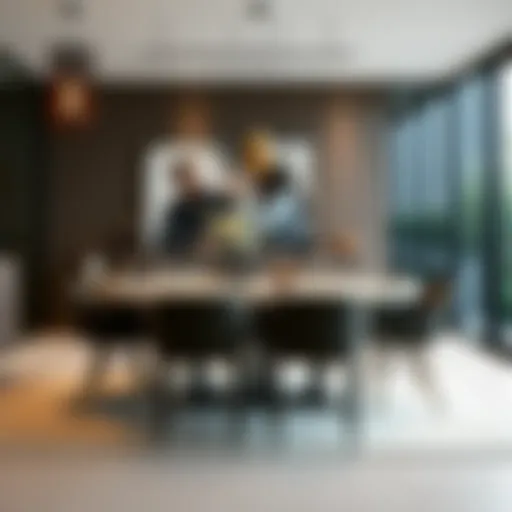Non-Slip Floor Runners: Safety and Style Combined
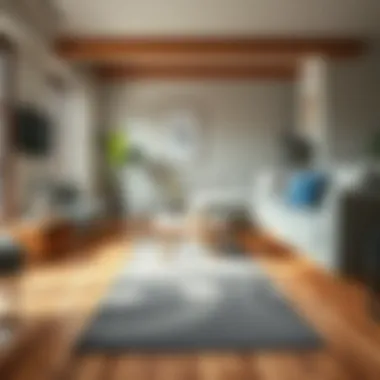
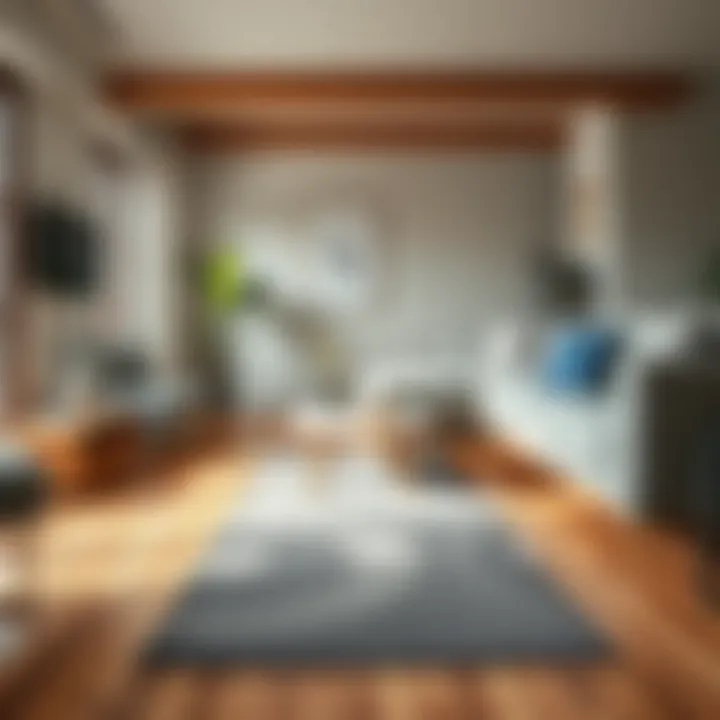
Intro
In today’s design landscape, the conversation around non-slip floor runners is gaining traction due to their dual role in safety and aesthetics. In various environments—homes, offices, and retail spaces—these runners are more than a mere accessory; they are a necessity. The slippery surfaces can pose a multitude of risks: a careless step could lead to accidents that may cause injuries or damage. Thus, incorporating non-slip runners can significantly bolster safety while also enhancing the overall design of a space.
Non-slip floor runners have evolved from utilitarian products into stylish elements that contribute to a room's ambiance. As architects and interior designers, understanding the breadth of options available is key. This article aims to navigate through the intricacies of selecting the right non-slip runners, the materials employed, and the latest design trends that marry functionality with flair.
As we dive deeper into this topic, one cannot overlook the importance of the available choices in materials and styles. From intricate weaves to modern geometric patterns, the market is replete with options catering to varied tastes and requirements. Whether one is looking to outfit a busy restaurant or a tranquil home office, there is something for everyone.
So buckle up, as we embark on an enlightening journey through the world of non-slip floor runners, exploring their significance and the practical designs that make them indispensable.
Understanding Non-Slip Floor Runners
Non-slip floor runners have become increasingly vital in various sectors, serving as both a safety measure and a decorative element. Their practicality extends beyond merely preventing slips and falls; they also enhance the visual appeal of spaces. In environments where foot traffic is expected, such as commercial settings or busy households, understanding the role of these runners is key. The right non-slip runner not only provides assurance against accidents but equally complements the overall design of the area.
Why are Non-Slip Floor Runners Important?
The primary purpose of non-slip floor runners is to act as a barrier against accidents caused by slippery surfaces. In settings like kitchens, bathrooms, and entryways, the likelihood of a slip increases dramatically, particularly when surfaces are wet or greasy. Interestingly, these runners can often be the unsung heroes of interior design, serving a dual purpose of safety and style. They come in a variety of materials, colors, and patterns, ensuring widespread applicability across decor schemes.
In commercial spaces—like restaurants, retail stores, and offices—non-slip floor runners are a must-have. They help maintain a safer environment for both employees and customers. Clients, especially in places with high foot traffic, appreciate a space that feels secure underfoot. By utilizing such runners, businesses can lessen liability issues and create an inviting environment without compromising safety.
The importance of non-slip runners cannot be overstated. They are not merely functional items; they also reflect an owner’s aesthetic sensibilities and understanding of space dynamics. A well-chosen runner can accentuate a design theme, potentially turning an ordinary hallway into a visually stunning feature.
"Safety and design aren’t opposites; with non-slip floor runners, they become partners."
In summary, understanding non-slip floor runners encapsulates their safety benefits and aesthetic contributions, making them important components in both residential and commercial settings.
Definition and Purpose
A non-slip floor runner is a long, narrow rug or mat designed specifically to provide traction, thereby reducing the risk of slips and falls. Constructed from various materials—like rubber, fabric, or vinyl—these runners feature textured surfaces that grip well underfoot. The purpose of a non-slip runner goes beyond safety; it also serves to define spaces, guide traffic flow, and add layers of warmth or color to a room.
For instance, in a brightly lit kitchen, adding a runner that resonates with the countertops may not only enhance safety but also elevate the visual aesthetic. A runner serves as an extension of one’s style and enhances the functionality of the space.
Varieties of Non-Slip Runners
When it comes to choosing non-slip floor runners, there are several varieties available. Each type comes with its distinct characteristics suited to specific needs:
- Rubber Runners: Known for their robust traction, rubber runners are ideal for moist areas like bathrooms or kitchens. They can endure high foot traffic without losing their grip. The ease of cleaning is an added bonus; simply wipe them down, and they’re good as new.
- Fabric Runners: Fabric options, which include cotton or synthetic fibers, can add an inviting touch to living areas. These runners often come in various patterns and colors, allowing for more personalization. However, regular cleaning is essential to maintain their appearance and functionality.
- Vinyl Options: Vinyl runners offer a combination of durability and diversity. They tend to be water-resistant and come in an array of styles—perfect for commercial spaces where design is as important as practicality.
Each variety caters to different consumer demands and environments, balancing safety with aesthetics effectively. Understanding these options is crucial for selecting the best non-slip runner for your needs.
Safety Considerations
The importance of safety can’t be overstated when it comes to choosing floor materials for any space. Non-slip floor runners play an integral role in preventing accidents, especially in environments where foot traffic is high. With falls and slips causing countless injuries every year, it is crucial for both residential and commercial settings to invest in solutions that enhance safety. Why focus on non-slip options? Because they help in reducing the risks while maintaining functional design and aesthetic appeal.
Preventing Slips and Falls
Incorporating non-slip runners is an effective way to tackle the common problem of slips and falls. These products have specific features designed to provide traction, even on seemingly smooth surfaces. Many types utilize textured materials or rubberized backings that grip the floor securely, acting like a spongy layer that cradles your feet and minimizes slip potential. Let’s unpack some of the ways these runners assist in preventing mishaps:
- Traction Control: The unique surface materials, like textured rubber or specialized fabrics, serve to increase friction where it matters most. When stepping on these runners, you are more likely to maintain your footing.
- Shock Absorption: Many non-slip runners have padding that helps absorb the impact when you walk, making them not just safer, but also more comfortable for the feet. This helps to alleviate fatigue, especially in spaces where people stand for long periods.
- Visible Warning: Brightly colored or patterned runners can catch the eye and signal caution to anyone who may not be paying full attention. The visual aspect is critical, serving as a gentle reminder to tread carefully, particularly in areas that tend to be slippery.
"The choice of flooring can either enhance or sabotage the overall safety of a space. Non-slip runners are one effective guard against slips and falls."
Recommended Environments for Use
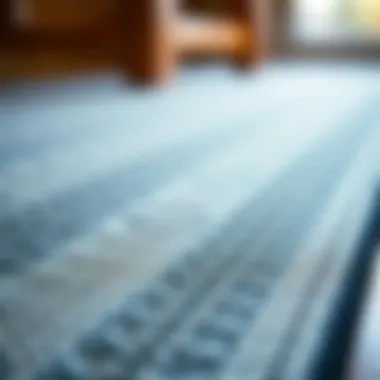

When it comes to deploying non-slip floor runners effectively, the environment dictates the choice. Not all settings are created equal, and knowing where to place these runners can make all the difference in safety. Here are some recommended environments:
- Kitchens: Given the moist surfaces often present due to spills, non-slip runners can significantly reduce hazards. The kitchen can be a busy, chaotic space; adding runners can provide peace of mind while preparing food.
- Bathrooms: A notoriously slippery area, using non-slip runners near shower entrances or sinks can reduce the likelihood of falls.
- Entryways: These high-traffic zones are often the first encounter visitors have. A non-slip runner can provide a safe transition from outside to inside, cutting down on tracked-in moisture from shoes.
- Commercial Spaces: Offices and retail shops that experience foot traffic are ideal candidates for non-slip runners. They not only enhance safety but can also contribute to the overall decor, attracting customers while protecting employees.
- Industrial environments: Factories and warehouses often deal with oils or other slippery substances. Runners specifically designed for industrial use can withstand rigorous wear while minimizing slip risks.
Emphasizing the correct environments for non-slip runners allows you to optimize safety and functionality. By placing these products in strategic locations, you can protect the well-being of individuals in various settings.
Material Choices for Non-Slip Runners
When it comes to non-slip floor runners, choosing the right material can make all the difference. Each option has its distinct features, benefits, and drawbacks that can enhance or detract from their effectiveness and aesthetic appeal. The choice of material not only impacts functionality but also influences the overall design and feel of the space in which they are installed. A well-made runner can provide exceptional safety while complementing the surrounding decor. In light of this, let’s explore three popular material choices:
Rubber Runners
Rubber runners are often the go-to choice for many environments due to their inherent anti-slip properties. The robust nature of rubber offers a fantastic grip, reducing the risk of slips and falls significantly. This quality makes them particularly suitable for high-traffic areas like kitchens and hallways where safety is paramount.
In addition to safety, another appealing aspect of rubber is its durability. Rubber can endure heavy use and harsh cleaning conditions, making it a long-term investment. They are also available in a plethora of colors and designs, allowing for versatility in aesthetics. However, one should remember that the texture and feel might not suit every environment. For instance, while they work great in functional spaces, rubber runners may appear out of place in more refined settings such as a formal living room.
"A rubber runner in the kitchen can be your best friend—offering both safety and comfort when standing for long periods."
Fabric Runners
Fabric runners deliver a warm, inviting touch to any space. They are often chosen for areas where aesthetics trumps the necessity for extreme durability. A well-chosen fabric runner can harmonize beautifully with the existing decor, pulling together various design elements. Think of a gentle, patterned fabric runner drawing attention to a well-furnished hallway or a cozy living room.
However, it’s crucial to look for fabrics that incorporate a non-slip backing. Synthetic materials can offer greater resistance to stains and wear, and some have moisture-wicking properties, making them more suitable for environments prone to spills. On the downside, fabric runners may require more frequent cleaning and maintenance, especially in households with pets or children.
Vinyl Options
Vinyl runners represent a balance between performance and style. With advancements in technology, modern vinyl offers not only slip resistance but also a wide array of textures and prints that can mimic the look of natural materials like wood or stone. They can be an astute choice for businesses looking for a polished floor treatment without sacrificing security.
Their practicality extends to being waterproof and easy to clean, which is enormously beneficial in busy commercial settings or homes with kids and pets. They also hold up well against wear and tear, typically available at a lower price point compared to other materials. However, one should remain cautious, as lower quality vinyl can feel less luxurious and may not last as long as rubber or high-grade fabric in demanding situations.
Design Aesthetics
When it comes to non-slip floor runners, aesthetics play a pivotal role alongside functionality. The intersection of safety and style is where these runners shine, making them not just practical but also an integral part of interior design. Taking the time to consider design aesthetics can elevate a space, transforming how it looks and feels while ensuring safety for everyone who uses it.
Color and Pattern Choices
Color and pattern selections are crucial elements in the design of non-slip runners. A well-chosen hue can subtly enhance the interior, contributing to a cohesive atmosphere. In contrast, bold patterns can serve as eye-catching focal points, injecting personality into the space. For instance, consider a vibrant geometric pattern that adds flair to an otherwise muted room. Alternatively, a soft pastel or monochromatic runner can integrate seamlessly into a minimalist design, providing safety without overshadowing the overall decor.
- Practical Tips for Color Selection:
- Pattern Consideration:
- Match the runner to dominant colors in the room for harmony.
- Use contrasting colors to create a vibrant accent.
- Consider darker shades that are more forgiving when it comes to stains and wear.
- Larger patterns can create the illusion of more space, ideal for smaller areas.
- Intricate designs may hide dirt better compared to solid ones.
Matching with Interior Design Styles
The ability to pair non-slip runners with various interior design styles significantly expands their appeal. For instance, in a modern minimalist setting, a sleek, solid-colored runner can enhance the clean lines and uncluttered look. On the other hand, in a traditional home, intricate patterns or rich colors can emphasize elegance and warmth. Aligning the runner with the existing design style not only reinforces the overall aesthetic but also makes a statement about sophistication and attention to detail. Think of adding a bold, art-deco inspired runner in a contemporary loft, creating a striking contrast that showcases both styles beautifully.
Trends in Non-Slip Runner Designs
Staying ahead of the trends in non-slip runner designs ensures that a space remains stylish while retaining its practicality. In recent years, there’s been a notable shift towards sustainable materials, with many manufacturers opting for recycled or eco-friendly fibers. This trend not only contributes to environmental preservation but also appeals to the growing demographic of eco-conscious consumers.
"As consumers become increasingly aware of their impact on the planet, choices in home decor are reflecting more sustainable practices."
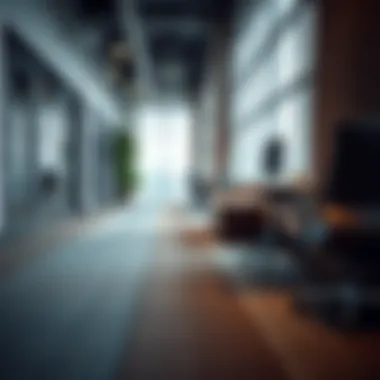

Furthermore, customization has gained traction. Homeowners and designers alike are opting for bespoke runners that cater to specific dimensions, colors, and patterns that are unique to their preferences. Smart technology integration is also on the rise, with some runners being designed to monitor foot traffic or detect moisture, pushing the boundaries of both safety and design.
Practical Applications
When it comes to non-slip floor runners, their practical applications paint a vivid picture of safety, aesthetics, and utility in diverse environments. These elements play a significant role in both residential and commercial spaces, addressing the unique challenges of each setting. Being just a strip of fabric or rubber can make all the difference between a slip-up and a stable stride.
Residential Use
In the home, non-slip runners prove invaluable, especially in high-traffic areas such as hallways, kitchens, and bathrooms. For families with young children or elderly members, the need for safety becomes paramount. A non-slip runner can significantly mitigate the chances of falls, which can sometimes lead to severe injuries.
But safety doesn’t mean sacrificing style. Many homeowners now look for designs that complement their interior decor. From bold geometric patterns to subtle hues, these runners can enhance the warmth of a living space while quietly doing their job. It’s also worth mentioning that they can act as effective noise dampeners, absorbing sound and reducing echoes — something always welcome in busy family homes.
Commercial Settings
Businesses too recognize the undeniable advantages of investing in non-slip runners. In places like restaurants or retail stores, spills and foot traffic can lead to dangerous slippery surfaces. Here, non-slip floor runners not only enhance employee security but also improve customer confidence when navigating through the space.
The variety in materials and designs allows for seamless integration into any business aesthetic, whether that’s a slick corporate office or a cozy café. Furthermore, commercial settings often have high cleaning standards; non-slip runners serve to protect the underlying flooring from high traffic wear and tear, thereby extending the longevity of the original floor materials.
Industrial Environments
In more demanding environments, such as factories or warehouses, non-slip runners serve a critical role in workplace safety. These spaces can see heavy machinery and fast-paced movements, where the risk of slips and falls is significantly elevated. Utilizing industrial-grade non-slip runners can help define walk paths, enhancing visibility while simultaneously reducing the risk of accidents.
Beyond just safety, these runners can be specifically designed to withstand chemicals and heavy loads, proving more resilient than standard home varieties. Their robustness makes them essential in ensuring compliance with occupational safety regulations, ultimately safeguarding both workers and companies from unnecessary liabilities.
"Non-slip runners are not just functional; they're a vital layer of protection in our fast-paced lives, whether at home, work or in industry."
Maintenance and Longevity
When investing in non-slip floor runners, understanding maintenance and longevity is crucial. The effort put into proper care not only keeps these runners looking sharp but also extends their usability, ultimately offering greater value for your money. A well-maintained floor runner can function effectively and enhance the aesthetics of your space for years to come. Therefore, it’s pertinent to dive into specific cleaning techniques and durability factors that influence the lifespan of these essential accessories.
Cleaning Techniques
Maintaining the cleanliness of your non-slip runners is essential for both hygiene and appearance. Here are some effective cleaning methods tailored for various materials :
- Vacuum Regularly: This is the easiest way to keep dust and dirt at bay. A good vacuum cleaner can remove buildup without causing damage.
- Spot Clean: For stubborn stains, a mild detergent mixed with water can work wonders. Dab the solution on the stained area gently and use a cloth to blot, rather than rub, to avoid spreading the stain.
- Machine Wash: If you have fabric runners, check if they are machine washable. Many are, making cleaning a breeze. Just be mindful of the washing temperature to avoid shrinking or damaging the non-slip grip.
- Protect with Powder: For rubber runners, using a safe powder can help keep them fresh. Sprinkling cornstarch or baking soda can absorb moisture and odors, particularly in high-traffic areas.
Routine cleaning not only ensures a visually appealing environment but also plays a part in maintaining slip resistance by preventing grime buildup that can create slick spots.
Durability Factors
When evaluating the durability of non-slip runners, several factors can impact how long they last:
- Material Quality: High-quality rubber and durable fabrics exhibit greater resilience. Premium materials resist wear and tear better than budget options.
- Tread Design: The pattern of the grip on the underside of rubber runners can affect durability. Deeper grooves typically resist slipping better and can last longer under heavy use.
- Environmental Factors: Consider where the runners will be used—indoors versus outdoors. Exposure to elements like moisture and sunlight can deteriorate materials faster. For outdoor options, ensuring water resistance is key.
- Usage Frequency: Heavy foot traffic shortens the lifespan of any runner. In commercial settings, it may be worth investing in thicker, more robust runners that can withstand constant use without losing their functionality.
"With the right care, your non-slip runners can be a long-lasting ally in maintaining safety and style in any space."
Cost Considerations
In any purchase decision, cost remains a pivotal factor—especially when it comes to non-slip floor runners, which serve both functional and aesthetic purposes in various settings. Understanding the financial implications helps in making informed choices that align with budget constraints without compromising safety and style. Non-slip runners come in an array of materials and designs, each influencing the overall cost. Thus, it's essential to evaluate not just the sticker price but also the lasting value these items can provide in the long run.
Price Ranges of Different Materials
When we talk about non-slip runners, materials play a significant role in determining their cost. Here's a breakdown of common materials and their usual price ranges:


- Rubber: Known for its traction, rubber non-slip runners can generally range from $30 to $100 per runner, depending on the thickness and brand. Their durability makes them suitable for high-traffic areas.
- Fabric: These runners often boast elegant designs and friendly textures, costing between $25 and $85. However, fabric runners may require more care, influencing their lifespan and maintenance costs.
- Vinyl: Typically the most cost-effective option, vinyl runners can be found from $15 to $50. While sure to keep budgets tight, they might not always offer the same longevity and comfort as rubber or fabric alternatives.
It's important to remember that these are rough estimates. Actual prices can fluctuate due to factors such as brand reputation, design intricacies, and where they are purchased.
"Investing in quality non-slip runners pays off in safety and design, potentially avoiding higher costs associated with injuries or replacements down the line."
Long-Term Value Assessment
While the initial cost of non-slip runners might catch the eye, the long-term value is what truly counts. A seemingly pricier rubber runner could outlast a cheaper fabric option, consequently saving money over the years due to reduced replacements and maintenance.
Here are a few considerations for assessing long-term value:
- Durability: High-quality materials typically resist wear and tear, proving their worth in busy environments where constant use is the norm.
- Maintenance Costs: Some runners might need frequent cleaning or specialized care, which could add to your expenses over time.
- Safety Benefits: Avoiding slips and falls results in fewer insurance claims and injuries which can be costly and stressful.
- Aesthetic Appeal: High-quality designs not only enhance your space but can also affect property value, making your investment worthwhile.
By scrutinizing these elements, one can gauge the true cost-effectiveness of each non-slip runner option. Buyers should be prepared not just to pay for a product, but also to understand the broader financial implications it carries for their safety and design goals.
Future Innovations
As we glide into a future where our environments continue to evolve, the role of non-slip floor runners is being redefined with innovative solutions. This section discusses emerging materials and smart technology that are shaping the next generation of non-slip floor runners. These advancements not only focus on enhancing safety but also prioritize aesthetics and environmental considerations. In a landscape where design and functionality meet, understanding future innovations offers a pathway to making informed decisions that balance practicality and style in both residential and commercial spaces.
Emerging Materials
In recent years, manufacturers have been experimenting with a variety of new materials that promise improved performance and durability. Here are a few noteworthy trends to keep an eye on:
- Eco-Friendly Options: Many consumers are more conscious about the environment nowadays. Biodegradable and sustainable materials have started to hit the market. For example, bamboo fibers are becoming increasingly popular for their durability and eco-friendly characteristics.
- Advanced Synthetic Materials: Technology has paved the way for synthetic materials that mimic natural textures. These materials combine the non-slip properties with a sophisticated look, appealing to a more upscale market.
- Textured Surfaces: Innovations in texture can create visually appealing designs while enhancing slip resistance. A runner featuring a combination of raised and flat areas can provide both grip and a unique aesthetic.
- Antimicrobial Treatments: With hygiene being a primary concern, non-slip runners are now often treated with antimicrobial finishes. This is especially valuable in environments like hospitals or schools, where cleanliness is paramount.
The importance of these materials cannot be overstated. They not only improve the safety and longevity of non-slip floor runners but also align with consumers' growing demand for products that are both functional and environmentally responsible.
Smart Floor Runners
The advent of smart technology is another game-changer for non-slip floor runners. Imagine floor runners that can do much more than just prevent slips. Here are some potential features of these modern marvels:
- Integrated Sensors: Some non-slip runners are being developed with built-in sensors that detect when someone is approaching. They can activate lights to guide individuals safely, especially in dimly lit areas.
- Real-Time Monitoring: Smart runners can monitor foot traffic and communicate with building management systems. This info can lead to insights about wear patterns and assist in preventative maintenance.
- Customizable Alerts: With smart technology, these floor runners could send alerts in case of spills or worn-out areas, reducing the risk of accidents in commercial settings.
- Connectivity: The integration with smart home systems lets users check the condition or cleanliness of the runners through their smartphones, promoting a more interactive user experience.
These innovations present substantial benefits, enhancing both safety and convenience in frequently used spaces.
"As technology and design intertwine, the future of non-slip runners promises not only to protect but to enhance your space's functionality and beauty."
The End
Non-slip floor runners stand as a significant element in enhancing both safety and aesthetics across various environments. Their implementation is not just a matter of style but rather an integral aspect of safety management in residential, commercial, and industrial spaces alike. Today, the importance of these runners goes beyond preventing slips; they contribute to improving overall ambiance and can tie together the design of a space.
Recap of Key Points
In this article, we explored:
- The definitive characteristics and purposes of non-slip floor runners, highlighting their protective roles.
- The diverse varieties of these runners, from rubber to vinyl, showcasing their suitability for different surfaces.
- Essential safety considerations that bolster their necessity in public and private spaces.
- The aesthetic possibilities available, discussing color schemes, pattern choices, and how they can complement various design styles.
- Practical applications and environments where non-slip runners excel, thereby enhancing their value.
- Important maintenance tips to prolong the lifespan of these accessories while ensuring they're always safe to use.
- An analysis of cost factors, helping readers understand the investment value of such products.
- Emerging trends and future innovations that make the choice of runners even more captivating and useful.
The intersection of safety, practicality, and design allows non-slip floor runners to shine as an indispensable addition to any space. Understanding their functionality and benefits empowers designers, architects, and retailers to make informed decisions that balance their client’s safety needs with their preferences for style.
Final Thoughts on Non-Slip Runners
As we look to the future, it is crucial to recognize that non-slip floor runners are not merely functional items but also integral components of design practices. By selecting the right runner, one can effortlessly marry safety with aesthetics. The evolution of materials and designs suggests that we are on the cusp of even more innovative solutions that will further blend utility and visual appeal.
Incorporating these runners into spaces is akin to laying down the groundwork for a safe yet stylish environment. With thoughtful selection and placement, non-slip runners can enrich the spaces they occupy, reflecting both a proactive stance toward safety and an elegant design sensibility.
"Design is not just what it looks like and feels like. Design is how it works." – Steve Jobs
To explore further into non-slip floor runners, including specific brands and shopping options, check out useful resources such as Wikipedia, Britannica, or platforms like Reddit. Stay informed and inspired!















